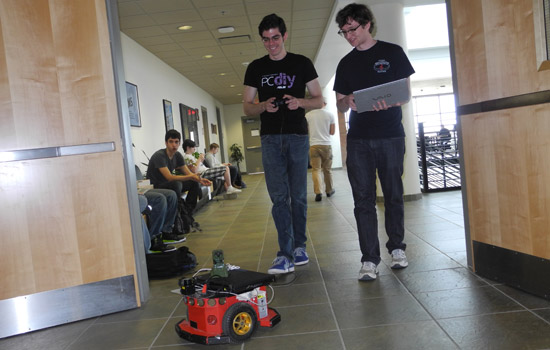Robots help students learn about computer science
Watch out for the Nerf-dart-shooting robots in Golisano Hall during the Imagine RIT: Innovation and Creativity Festival May 4 at RIT.
While wandering through the Computer Zone May 4 at the Imagine RIT: Innovation and Creativity Festival, be on the lookout for any pesky, Nerf-dart-shooting robots.
Faculty and students in RIT’s Department of Computer Science have outfitted Lewis and Clark, their two Pioneer 3-DX robots, with Nerf-dart turrets and remote controllers for an interactive exhibit on the second floor of Golisano Hall. Festivalgoers can learn how robotics is used to teach a variety of topics across the domain of computer science, while shooting Nerf darts across the room.
“The robots are actually used in my Mobile Robot Programming course,” says Zack Butler, an associate professor of computer science. “The addition of the Nerf turrets was just for fun.”
Butler uses the robots in his course because they are equipped with forward-facing sonar rings and bump sensors that make the robots autonomous. Students must implement various algorithms to program robots that will never face the same pattern of situations twice.
“Autonomous programing is often difficult, but it can help students learn everything from database security to map building,” says Butler. “But for Imagine RIT we thought it might be more fun to make the robots remote-controlled.”
Daniel Capobianco, a third-year computer science major, and Tristan Goetz, a computer science graduate student, worked with Butler to integrate existing open source player stage code and open source code for the Nerf turret to make the remotely operated Nerf-dart-shooting robots functional.
The work done in the Robotics, Networking, Data Management Lab has even led to a project to develop a team of corobots that can be used by students in several different computer science classes at RIT. The project, which is supported by a National Science Foundation award, will use a team of self-navigating robots that interact with people in Golisano Hall, both locally—through a mounted netbook or tablet—and remotely over the Internet. The educational tool uses a software architecture that allows students to see their code as it executes and monitor it.















